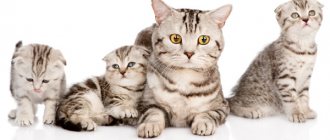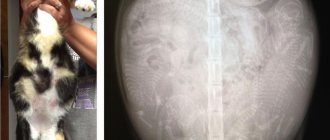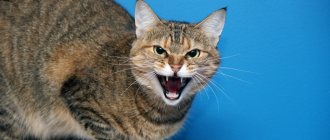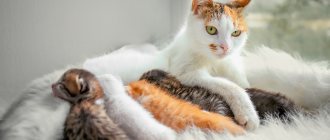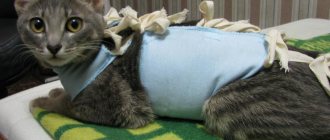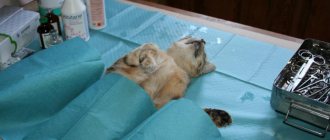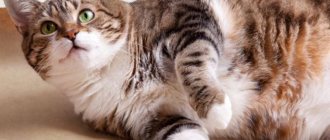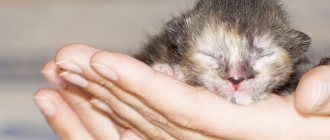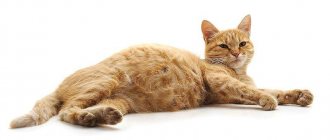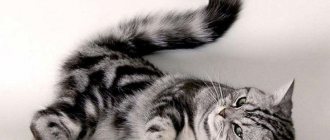The birth of kittens is not always considered a source of unnecessary problems that one wants to get rid of as quickly as possible. Many owners are looking forward to adding a new addition to their pet family and are specifically looking for a good partner for their pet. But how can you understand that a cat is pregnant in order to surround it with care and attention from the first days?
How can you tell if a cat is pregnant?
Signs of pregnancy in the first days
In the first days after fertilization, it is almost impossible to suspect pregnancy in a pet. Only some subtle signs will indicate its condition, but they do not give a 100% guarantee:
- increased drowsiness - a particularly noticeable sign in active cats, as playfulness gives way to calmness, in this case the owner may suspect the appearance of a somatic disease. This condition is formed due to changes in the hormonal background of the animal;
- cessation of estrus earlier than usual is an indirect sign of conception. On average, the period lasts about three days, so a reduction in the duration of the phase may indicate fertilization;
- a few days after mating, there may be a decrease in appetite due to the occurrence of nausea in the animal, while normally a pregnant cat does not experience frequent vomiting and complete refusal of food, such symptoms may indicate the presence of a disease;
- changes in nipple pigmentation occur under the influence of hormones, while the skin intensifies its color; this sign is in many cases difficult to detect from the first days of pregnancy.
Also read the article about when a cat starts walking.
Nutritional Features
Nutritional needs change throughout pregnancy. The first two weeks, when appetite increases slightly, the daily portion is increased by 10%. In this case, the entire volume of food is divided not into 2 meals, as usual, but into 4–5. From 3 to 7 weeks, the amount of feed is doubled from the original. Over the last fortnight, my appetite has decreased slightly as the fruits put pressure on my internal organs.
Pregnant cats have a good appetite
The diet should not contain foods from the human table, especially those containing chemical additives - chips, sausages, smoked meats, including fish. This is harmful to all domestic animals, and their benefits for humans are questionable.
Nomes for feeding cats
Attention! It is important not to exceed recommended servings. This is harmful both for the cat and for the litter formed in the womb. The large body weight and size of kittens can complicate birth. Difficulties also arise with feeding the offspring.
Dry or natural food?
Cat breeders have not yet come to a consensus on which food is better - industrial or natural. But they agree on one thing: if it is ready-made food, then it must be the highest quality available. Switching to a different type of diet will do more harm than good.
Cat breeders never tire of arguing about which food is best.
Dry food familiar to cats is gradually being replaced with analogues for pregnant women. If a special product cannot be found, then simply increase the portion as described above. Experienced breeders recommend special foods for pregnant cats:
Royal Canin Queen
Acana Pacifica
Bozita
Josera Minette for kittens and nursing cats
These brands fall into the holistic and premium categories. They contain a sufficient amount of fat, protein, and amino acids to provide the expectant mother with energy for pregnancy and strengthen her immune system.
Interesting! Feline nutrition experts sometimes recommend feeding kitten foods instead of regular food from the first days of pregnancy and several weeks after birth as an adequate source of protein and energy.
Kitten food is one of the options for complete nutrition for a pregnant or lactating cat.
In addition to the main diet, from time to time you can pamper your cat with natural products - meat, cottage cheese, yogurt. But then this is a delicacy, not the main food.
Many sources on cat nutrition note that it is not worth giving additional vitamins and minerals, since everything necessary is included in the product. Only a veterinarian can determine the possible need for supplements.
Natural nutrition
Breeders pay special attention to the natural nutrition of the cat.
Table 2. Qualitative composition of the diet of a pregnant cat.
| Name | Quantity, % |
| Squirrels | 25 |
| Carbohydrates | 25 |
| Fats | 12 |
| Cellulose | 2-3 |
| Minerals | 6 |
| Water | 29-30 |
Cats usually refuse plant foods. But if you grind it in a blender to a puree and mix it with meat products, then its taste buds can be deceived. You should not cut food into cubes, since only meat pieces will be selected from the plate.
A cat needs the following products:
- dietary meat - chicken, veal, beef (can be raw, but only fresh and high quality);
- sometimes - boiled fish;
- eggs - 2 pcs. in Week;
- low-fat dairy group - cottage cheese, yogurt, sour cream, cream, yogurt;
- cereals - oatmeal, rice, buckwheat;
- jelly, boiled cartilage.
Natural products are necessary for a pregnant cat
For constipation, give the cat beets and increase the amount of vegetable fat. But they are excluded or the dose is reduced after the condition has stabilized.
Attention! It is believed that animals are able to recognize what is harmful or spoiled by smell. This is just a myth. Therefore, it is necessary to ensure that only fresh and high-quality products are supplied to the pregnant woman’s table.
Herbal remedies for pregnant cats
Breeders recommend giving cats an infusion of raspberry leaves. It is prepared from a tablespoon of dry raw materials and a glass of boiling water, left for 15 minutes and filtered. Give a tablespoon 2 times a day from the beginning to the end of pregnancy. This will help bear healthy offspring and simplify the birth process.
In the second half of pregnancy, pre-scalded nettle leaves are added to the drink. These greens promote milk production.
Nettle decoction increases the amount of breast milk
Vitamin supplements for a pregnant cat
It is necessary to ensure the presence in the diet of vitamins A, D, E, B1, B6, B1, as well as calcium, phosphorus, iron, iodine. Taurine, a sulfur-containing amino acid, is extremely important. If the diet is prepared correctly and is not monotonous, the body receives most of these elements from food. But with an unbalanced diet, vitamin preparations with the listed substances are necessary.
The following brands offer vitamin complexes for pregnant cats:
- Beaphar (Top 10 Cat, Salvical, Irish Cal);
- Brewers Yeast 8 in 1;
- Anivital FeliImmun and others.
Vitamin preparations will provide vital elements
At what stage can pregnancy be determined?
So, how can you tell if your cat is pregnant? The owner can detect pregnancy in a cat starting from 28 days - during this period, the female experiences an increase in abdominal circumference, swelling of the nipples, changes in behavior, and cessation of estrus.
Ultrasound of a pregnant cat
By consulting a doctor, pregnancy can be detected from about 20 days after fertilization. For this, an ultrasound is performed, which will accurately determine the presence or absence of fetuses in the uterus.
Unlike people, cats do not secrete the hCG hormone into the blood, but instead the placenta secretes relaxin. Testing for this hormone can be done from the 20th day after mating. False-positive results are possible if the animal has an ovarian cyst.
From the 28th day you can notice the first movement of the offspring. During the same period, palpation can be carried out by palpating the side walls of the abdomen.
An X-ray of the abdominal organs is performed after 50 days of pregnancy. The method reliably diagnoses the fertilization that has occurred, and also allows you to determine the number of offspring and their position.
Observation by a veterinarian
An experienced veterinarian can easily determine if an animal is pregnant. Taking into account all individual characteristics, she will give valuable recommendations for care during this difficult period, and also tell you how to prepare for childbirth.
The doctor is able to identify a small embryo in the belly of the expectant mother after 20 days.
The clinic may offer to do an ultrasound examination. This will make it possible to find out in the early stages of pregnancy how many babies there will be? In addition, you can additionally do fluorography. With its help, within a month and a half, the skeletons of embryos are clearly visible. X-ray examination will allow:
- Find out exactly the number of babies in the litter;
- Perform early diagnosis of possible complications
The advantage of this research is safety for the animal and future offspring.
General signs of pregnancy
After mating, the owner must carefully monitor the condition of the cat, since the appearance of uncharacteristic symptoms may indicate a pathology of pregnancy. In addition, intercourse sometimes does not lead to fertilization, resulting in the need for additional mating.
The most informative signs of pregnancy include an increase in the size of the abdomen, changes in behavior, cessation of estrus and some other manifestations.
Termination of heat
Estrus refers to the manifestation of the period of arousal in the sexual cycle. The processes accompanying this stage are aimed at changing both the behavior and the state of the cat’s reproductive tract, which will contribute to attracting a male and fertilization. Accordingly, in the case of successful conception, continuation of estrus is not advisable, so signs of arousal disappear - the vaginal mucosa loses hyperemia, the secretion stops being released from the loop.
If estrus continues after mating, this indicates a failed pregnancy. If the lack of conception is confirmed, the breeder will have to resort to re-mating the female.
Changing nipples and belly
The earliest sign of pregnancy in a cat is a rounding of the abdomen due to an increase in the size of the uterus as a result of the growth of the fetus. The sign is usually detected after one month from the date of mating. The rate of growth of the abdomen, as well as its size, depend on the individual characteristics of the female, the number and size of the offspring. During this period, the first movement can be determined by palpation. To do this, carefully palpate the lateral sections of the abdomen.
Changes in nipple pigmentation begin in the first days after conception. The color becomes brighter, they acquire the maximum pink tint in the last stages. The greatest change in color is typical during a cat's first pregnancy. As delivery approaches, the nipples swell, which is a preparation for breastfeeding the offspring. Such changes are caused by the action of hormones.
The first release of milk, or rather colostrum, occurs approximately seven days before the kittens are born. The secreted substance contains a large amount of protein and fat, and subsequently its composition changes somewhat.
Behavior change
The most common symptoms are increasing weakness and lethargy. An active cat becomes calmer, spends most of its time lying down, and loses interest in games. In phlegmatic pets, the signs are less noticeable. This condition is associated with the action of hormones.
In some cases, there is an increase in activity - an unsociable cat begins to show affection and demand more attention, a sedentary cat becomes playful.
Sometimes a change in behavior is accompanied by the appearance of aggression, which is most often characteristic of sphinxes.
A sharp change in taste preferences is possible - the cat happily eats food that it did not like before, but refuses its favorite foods. The process is explained by a condition similar to toxicosis in women.
We recommend reading the article about discharge in a pregnant cat.
Nesting
The maternal instinct of a cat is expressed in the desire to create comfort for future offspring. An animal can actively look for a place to give birth - the pet will sniff it, spend a lot of time there, and drag soft objects there.
Most often, the animal chooses a secluded “den”, where there are no adverse effects of the environment - drafts, dampness, and also away from people. Care should be taken to ensure that the cat does not lamb in a place inaccessible to humans.
We recommend reading the article about how long pregnancy lasts in cats.
Changes in behavior
During the first weeks, aggression towards other cats may appear. The character changes in the second half of pregnancy. The cat becomes affectionate and tender. The last stage is accompanied by apathy. Most of the time is spent at home, even if there is the possibility of free walking.
Pregnant cat prefers sleep at home to walks
Breeders note that there are no special, pronounced changes in habits during almost the entire pregnancy. The exception is the time before childbirth. The expectant mother begins to look for a secluded corner, to “nest”, and wants the owners to comfort her.
Diagnosis and false pregnancy
To find out for sure that pregnancy has occurred, you need to consult a specialist. The doctor will conduct an examination and, if necessary, prescribe additional examination methods:
- An examination by a veterinarian involves palpation to identify fetuses, as well as an external examination of the genital tract and the general condition of the cat.
- A positive result of a blood test for relaxin will indicate with high accuracy the onset of fertilization from the 25th day.
- Ultrasound allows you to accurately diagnose pregnancy from day 25.
- X-rays are performed after 50 days.
Cats are characterized by the phenomenon of false pregnancy. The etiology is not fully understood, but experts are inclined to believe that the cause of the condition is the effect of the hormone prolactin. Imaginary pregnancy in cats occurs after ovulation in the absence of fertilization of the egg. At the same time, the cat shows signs of conception - changes behavior, nests, and stops estrus.
False pregnancy can be diagnosed by a negative test result for relaxin, the absence of fetuses on palpation, according to ultrasound and radiography.
Diet
Much attention should be paid to the pet's diet. A cat that eats commercial food should be switched to special food for pregnant women. If your pet eats natural food, low-fat fermented milk products, liver, and cereals should be included in the diet. Also, after consulting a veterinarian, the female should be given additional vitamins and mineral supplements. Serving sizes should be appropriate for the size, age and breed of the cat. You cannot overfeed the female, otherwise she may develop obesity, which will have a bad effect on pregnancy. Since growing kittens slightly compress the stomach, you should feed your pet more often. In this case, the daily portion of food can be increased by no more than 10%.
Features of caring for a pregnant cat
Pregnancy is a test for a cat’s body. Since all vital organs work in an intensive mode, the animal requires special care and attention. Favorable conditions play a big role in the course and outcome of the condition.
The cat should be kept in a spacious, well-ventilated room without drafts at a comfortable temperature. High humidity and dark lighting are unacceptable.
You should ensure that your cat does not climb onto high furniture, as a fall or awkward landing can lead to serious consequences.
In the later stages, you should help the cat with hygiene, since the large size of the abdomen does not allow the cat to carry out the necessary toileting of the genitals and fur.
From the author. If the cat is not on a natural diet, then during pregnancy and nursing it should be switched to kitten food of at least premium class, and preferably super premium or holistic. Read a separate article about the right choice of premium food for kittens.
What to feed
The general principles of feeding a pregnant cat include following some rules:
- The diet should consist of high-quality feed, rich in all necessary substances.
- It is recommended to provide easily digestible food.
- A pregnant cat requires more frequent feeding. By the second trimester, the daily norm increases by about 50%.
- In the later stages, you should resort to fractional meals 6 times a day.
- It is important to regularly check the presence of water in the drinking bowl. Dehydration leads to abortion, which can cause the death of the cat.
Also read the article about whether a pregnant cat can be sterilized.
How to tell if your cat is pregnant or just fat?
In addition to the signs below, consulting a veterinarian is a way to get some confirmation that your cat is pregnant. An ultrasound will determine the state of pregnancy and the number of heartbeats after 40-45 days of pregnancy.
If your cat doesn't show the signs below, she's probably just fat. You can check to see if your cat has gained extra weight by running your hands along its side, as if you were petting it. If you can feel his ribs by applying gentle pressure, your cat is likely at an ideal weight. If you have to press hard to feel his ribs, it could be excess weight. If you can't feel his ribs at all, your pet may actually be obese.
Symptoms of the onset of labor
Early warning signs of childbirth are sagging of the abdomen as a result of relaxation of the ligaments, as well as retraction of the sacral region.
On the eve of delivery, swelling of the genital organs and mammary glands occurs, and droplets of colostrum are released. Viscous mucus without pathological impurities comes out of the loop.
Read the article about bleeding in a pregnant cat.
When labor occurs, the water breaks, releasing a grayish-pink fluid. Then contractions appear, which normally last for an hour, which, if the outcome is favorable, end with the birth of offspring.
Determining if a cat is pregnant using ultrasound
Ultrasound of a cat during pregnancy is a common, painless and quick way to determine the period and problems of bearing offspring. The study will allow timely recognition of deteriorating animal health.
Diagnostics helps to see embryos as early as 2 weeks of pregnancy. After 4 weeks, the specialist will determine the exact number of kittens, check the activity of their hearts, and the condition of the cat itself. The movement of the fetuses is recorded, body parts and internal organs of the kittens are recognized. By the end of the 8th week, it is important to determine whether the amount of amniotic fluid is decreasing: the kittens are swallowing liquid. Reducing water levels and the size of the fetuses help the specialist determine the estimated due date for the pet.
First pregnancy
Puberty of the female occurs on average at 7-8 months of life. In this case, the cat experiences gradually changing periods of the cycle.
- The arousal stage corresponds to the period of maximum readiness of the animal for conception. Changes in the genital organs occur under the influence of gonadotropic hormones. In this case, the appearance of estrus is observed, which is characterized by swelling, edema and hyperemia of the vulva, and the release of mucus from the loop. Sexual arousal is accompanied by a change in the pet’s behavior - the cat becomes restless, active, and its appetite decreases. Next, the heat stage is formed, which is characterized by the female’s readiness to mate; at this moment she looks active and restless. Ovulation is the release of a mature follicle. This process in cats has its own peculiarity - the mechanism starts only after sexual intercourse after 1-2 days.
- The period of inhibition indicates a decrease in sexual activity. At this moment, the cat’s estrus ends: the mucous membranes of the genital tract return to their normal state, and the secretion of mucous secretion stops.
- The balancing period is characterized by the restoration of the cat's behavior and lack of attraction to males.
It is most favorable for the first pregnancy to occur at the age of more than a year, since the animal’s body reaches a mature state. Conceiving at a younger age can lead to pregnancy pathologies, complicated childbirth and diseases of the offspring. We recommend reading the article about a cat’s first birth.
1111
Preparing for childbirth
Often pets give birth so quietly and carefully that the owner does not even have time to notice any traces of the event. But in case of complications, the pet may need human help, so it is better to find out in advance how to determine that a cat is giving birth and carefully prepare for this event.
By the end of the third trimester of pregnancy, a caring owner should stock up on items and medications that may be useful during childbirth, as well as immediately after it. So, if you are worried about the health of your pet and her future children, you should definitely have on hand at the time of lambing:
- Oxytocin is a drug that stimulates labor in case it is delayed.
- Sterile latex gloves.
- Sterile scissors and thread.
- Antiseptic agents in powder and liquid form intended for animals.
- Zelenka and cotton balls for treating the umbilical cord.
- A special suction, bulb or pipettes to remove fluid from the kitten’s respiratory tract if it begins to choke.
- Clean terry towels for drying kittens.
- Phone veterinarian for urgent consultation.
- Cat milk replacer (she may not get it).
- A durable cardboard box for kittens with low sides (it doesn’t matter whether you buy it at a pet store or make it yourself - the main thing is that the cat can freely “travel” from and to it without disturbing the kittens).
Symptoms of a successful mating
Days 3–5 of estrus are considered optimal for fertilization. Therefore, as soon as the kitty starts to flow, she is sent to visit the previously matched cat. The first day is spent getting used to each other and sorting out the relationship. Then the cat begins to wag its tail, provoking the male and immediately driving him away. Waiting for a cat owner can be tedious, and the act of intercourse goes unnoticed. How can one determine that mating has taken place? This is indicated by the following symptoms:
- the cat rolls on the floor;
- the vulva becomes red and swollen:
- the cat leaves his friend and begins to lick the genitals;
- when a repeated desire arises, the male receives a decisive rebuff;
- the female loses her appetite and falls into a lethargic state that can last 100 hours.
Mating
How can a person help a giving birth cat?
If a cat, on the eve of lambing, has burrowed away from you in a far, secret corner, there is no need to disturb her. Just be prepared to quickly come to the rescue if trouble arises. But when your pet is nervous and doesn’t leave your side, she definitely wants help immediately.
In this case, you should definitely calm her down and caress her. Don't let your cat squat: this could harm her babies. Try to lay her down on her side by cuddling her and encouraging her with warm words. In addition, you can stimulate labor yourself by stroking your tummy and spine. When your pet pushes, allow her to rest her hind legs on your hand. Always keep clean, warm water on hand: an exhausted woman in labor will often experience increased thirst.
Clinical symptoms of tightness
In the first decade after intercourse, one can only guess about the success of conception. From the second ten days, the following signs of tightness are observed:
- the female becomes affectionate;
- toxicosis of pregnant women is observed;
- increased drowsiness appears, the animal sleeps 1–2 hours longer than usual;
- oddities are discovered in the cat’s behavior that were not previously noticed;
- pinking of the nipples;
- the female stops making sudden movements, jumping, jumping from high objects;
- appetite begins to increase;
- the reaction to cats is negative, even to the point of aggression.
After the mating has taken place, the cat rolls on the floor
What changes occur before childbirth?
It is very important for the owner to know the due date, because it is unknown how this process will go, and it may be necessary to provide assistance to the pet. You can find out when this period is approaching using the following signs:
- About 3 days before the onset of birth, the cat begins to look for a secluded corner, she looks for a suitable place, and begins to build a nest. To prevent this process from happening on your bed, it is best to prepare for it in advance. You can offer her a box covered with a warm cloth and a sheet on top.
- The cat's nipples sharply increase in size, from which colostrum is secreted. Mucus discharge is observed from the genitals.
- The temperature drops sharply by about 1 degree and can reach 37 degrees.
- 10 hours before the birth of the offspring, the pet hides in its nest. There is no need to disturb her; you can help at this stage by providing fresh water.
When should you contact a veterinarian immediately?
At this time, the cat especially needs a caring attitude from the owner. If she exhibits the following signs, you should call your veterinarian immediately:
- The pet refuses to eat for more than 2 days.
- Fever, above 39 degrees.
- The cat drinks a large amount of fluid and at the same time breathes heavily.
- The female licks herself very often, and dark discharge is observed from the loop. If the discharge is red, you should urgently take it to the clinic.
Attentive attitude to the animal after mating will help to easily determine the presence of pregnancy. Only a specialist will give more accurate information; he will also recommend methods of caring for the cat, tell you how to properly help her prepare for a difficult moment, and give recommendations for helping the animal during childbirth.
The birth process
Kittens ready to be born line up to be born in the animal’s two-horned uterus. The birth process is divided into 3 stages:
- The cat feels contractions of the uterus and at the same time the urge to have a bowel movement. The cervix begins to open slightly. Often at this stage the birth plug comes out along with mucous secretions.
- In the second phase, contractions become more intense and painful, the cervix opens completely, preparing to let the kittens move through the birth canal. The cat strains, trying with all her might to “push through” the cubs. This is how a healthy kitten is born with a favorable course of labor. If the amniotic sac has not burst earlier, the baby is born in it. Usually the woman in labor frees the kitten herself by gnawing the shell. But it happens that she leaves the place of birth in fright or gets lost during the first lambing, and then you must come to the rescue by cutting the bladder with sterile scissors so that the baby does not suffocate. The next cub should emerge 15, maximum 40 minutes after the first.
- At the final stage of labor, the placenta is separated from the mother. The cat must eat one of the nursery places - this will help her quickly realize that she is a mother and speed up lactation. Make sure that after each kitten there is an afterbirth. The placenta remaining in the pet’s body can rot, which will lead to severe inflammation and even death of the animal. At the same time, the cat may eat a stillborn or too weak kitten, which is best avoided.
Well, the birth is over. Make sure your pet has given birth to all the kittens by feeling her belly: it should be soft and empty. If you still have doubts, and the cat is in no hurry to feed and caress the cubs, but still shows signs of anxiety, seek advice from a specialist.
You can also contact our site's staff veterinarian, who will respond to them as soon as possible in the comment box below.
When mating has taken place or if the cat has run away from home during estrus, it is important to determine pregnancy as early as possible. The hormonal levels in the animal’s body change, so pregnancy affects the mood, behavior and appearance of the pet. It is often difficult for inexperienced owners to understand at home whether their cat is expecting a replenishment. Timely detection of signs will allow the cat to receive the necessary assistance for a successful birth in the future.
- Show all
